Granada
Nicaragua
city, southwestern Nicaragua. It lies at the foot of Mombacho Volcano on the northwestern shore of Lake Nicaragua at 202 feet (62 m) above sea level. Granada was founded in 1523 by Francisco Hernández de Córdoba, and it soon became the economic hub of the region. As the longtime headquarters of the Conservative Party in Nicaragua, the city greatly influenced the political life of the country for many years. It was also a keen political and trade rival of León city, farther north, which was the centre of the Liberal Party. Nicaragua's national capital, Managua, was founded between the two older cities as a political compromise. Granada was raided by pirates from the Caribbean many times in the 17th century. William Walker (Walker, William), the U.S. filibuster, made Granada the centre of his attacks and his headquarters; he sacked and burned the city in 1857.
It is typically Spanish in appearance and is laid out in a rectangular grid. Among its houses are many fine mansions. The city's churches are massive, and some are ornate. Granada is an industrial centre, manufacturing furniture, soap, clothing, cottonseed oil, and rum. It is the terminus of the Pacific Railway, which leads from Corinto on the Pacific through Managua to the northwest. Granada is linked to other cities by highway and to Managua by expressway, and steamers service lakeside towns. Pop. (2005) urban area, 79,418.
Spain
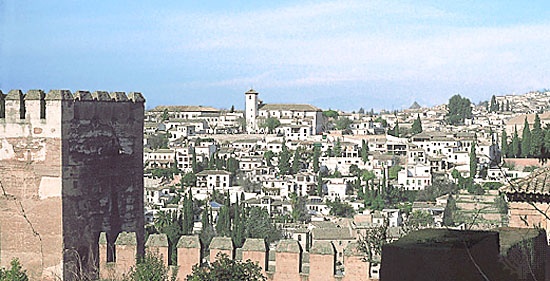
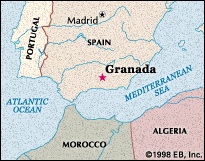
city, capital of Granada provincia (province) in the comunidad autónoma (autonomous community) of Andalusia, southern Spain. It lies along the Genil River at the northwestern slope of the Sierra Nevada, 2,260 feet (689 metres) above sea level. The Darro River, much reduced by irrigation works along its lower course, flows for about a mile into the city from the east before turning sharply southward to join the Genil. It is canalized and covered along much of its course through the city.
The city's name may have been derived either from the Spanish granada (“pomegranate”), a locally abundant fruit that appears on the city's coat of arms, or from its Moorish name, Karnattah (Gharnāṭah), possibly meaning “Hill of Strangers.” Granada was the site of an Iberian settlement, Elibyrge, in the 5th century BC and of the Roman Illiberis. As the seat of the Moorish kingdom of Granada (Granada), it was the final stronghold of the Moors in Spain, falling to the Catholic Monarchs Ferdinand II and Isabella I in January 1492.
 One of Spain's most frequently visited tourist centres, Granada contains many notable architectural and artistic monuments. The city is the see of an archbishop, and it is dotted with fine Renaissance, Baroque, and Neoclassical churches, convents, monasteries, hospitals, palaces, and mansions. At the centre of the city stands the Gothic Cathedral of Santa María de la Encarnación (1523–1703), containing the Royal Chapel (Capilla Real) with the tomb of Ferdinand and Isabella and a display of heraldic decoration. The cathedral is profusely ornamented with jasper and coloured marble, and its interior contains many fine paintings and sculptures by Alonso Cano (Cano, Alonso). The Cartuja, or Carthusian monastery (1516), stands in the north of the city. Near the restored monastery of San Jerónimo (1492) is the University of Granada, which was founded in 1526 and received its charter in 1531; it is now housed in a former Jesuit college. Statues of Christopher Columbus and Queen Isabella by Mariano Benlliure adorn the Monument of the Agreements.
One of Spain's most frequently visited tourist centres, Granada contains many notable architectural and artistic monuments. The city is the see of an archbishop, and it is dotted with fine Renaissance, Baroque, and Neoclassical churches, convents, monasteries, hospitals, palaces, and mansions. At the centre of the city stands the Gothic Cathedral of Santa María de la Encarnación (1523–1703), containing the Royal Chapel (Capilla Real) with the tomb of Ferdinand and Isabella and a display of heraldic decoration. The cathedral is profusely ornamented with jasper and coloured marble, and its interior contains many fine paintings and sculptures by Alonso Cano (Cano, Alonso). The Cartuja, or Carthusian monastery (1516), stands in the north of the city. Near the restored monastery of San Jerónimo (1492) is the University of Granada, which was founded in 1526 and received its charter in 1531; it is now housed in a former Jesuit college. Statues of Christopher Columbus and Queen Isabella by Mariano Benlliure adorn the Monument of the Agreements.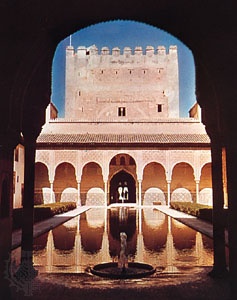
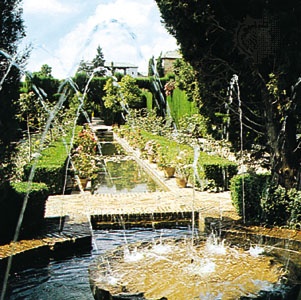 In the northeast of the city is the Albaicín (Albayzin) quarter, the oldest section of Granada, with its narrow cobbled streets and cármenes (Moorish-style houses). Albaicín is bounded to the south by the Darro River, and on the other side of the river is the hill upon which stands the famous Moorish palace the Alhambra, as well as the Alcazaba—the fortress that guarded it—and the Generalife, which was the summer palace of the Moorish sultans. Nearby is the 16th-century palace of Emperor Charles V. Other notable Moorish antiquities are the 13th-century villa known as the Cuarto Real de Santo Domingo and the Alcázar, which was built in the 14th century as a palace for Moorish queens. The Alhambra and the Generalife were collectively designated a UNESCO World Heritage site in 1984; the Albaicín was added in 1994.
In the northeast of the city is the Albaicín (Albayzin) quarter, the oldest section of Granada, with its narrow cobbled streets and cármenes (Moorish-style houses). Albaicín is bounded to the south by the Darro River, and on the other side of the river is the hill upon which stands the famous Moorish palace the Alhambra, as well as the Alcazaba—the fortress that guarded it—and the Generalife, which was the summer palace of the Moorish sultans. Nearby is the 16th-century palace of Emperor Charles V. Other notable Moorish antiquities are the 13th-century villa known as the Cuarto Real de Santo Domingo and the Alcázar, which was built in the 14th century as a palace for Moorish queens. The Alhambra and the Generalife were collectively designated a UNESCO World Heritage site in 1984; the Albaicín was added in 1994.South of the city centre is the administrative and commercial section of Granada, and to the west is the modern residential sector. Granada has an active trade in agricultural produce, and its manufactures include liqueurs, soap, paper, coarse linen and woolen fabrics, metals, and machine parts. The city is the venue of an international festival of music and dance. Spanish poet and playwright Federico García Lorca was executed by a Nationalist firing squad near Granada shortly after the outbreak of the Spanish Civil War. Pop. (2006 est.) 234,049.
historical kingdom, Spain
Arabic Gharnāṭa
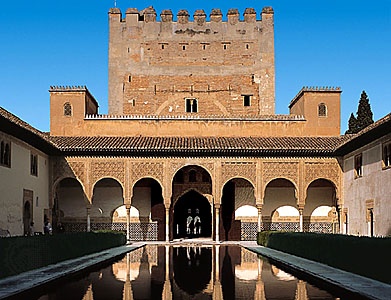 kingdom founded early in the 13th century out of the remnants of Almoravid power in Spain by Abū ʿAbd Allāh ibn Yūsuf ibn Naṣr al-Aḥmar, who became king as Muḥammad I (ruled 1232–73) and founded the Naṣrid dynasty. The kingdom comprised, principally, the area of the modern provinces of Granada, Málaga, and Almería. In 1246 Muḥammad I secured the recognition of Ferdinand III of Castile (his neighbour on all landed frontiers) in return for a vassalage which, though often ignored, remained in force until the kingdom's disappearance in 1492.
kingdom founded early in the 13th century out of the remnants of Almoravid power in Spain by Abū ʿAbd Allāh ibn Yūsuf ibn Naṣr al-Aḥmar, who became king as Muḥammad I (ruled 1232–73) and founded the Naṣrid dynasty. The kingdom comprised, principally, the area of the modern provinces of Granada, Málaga, and Almería. In 1246 Muḥammad I secured the recognition of Ferdinand III of Castile (his neighbour on all landed frontiers) in return for a vassalage which, though often ignored, remained in force until the kingdom's disappearance in 1492.Granada's history is one of internal crises because of the existence of a powerful landowning nobility with which, from the first, the monarchy had to come to terms, and because of wars with Castile. Successive kings of Granada sought political support and military aid from Morocco. Moroccan recruits caused the kingdom to undergo an intense process of arabization, to cut itself off from all Castilian influences, and to develop an absolute form of government based on military support. The central government's economic resources depended mainly on the silk industry and on external trade; the latter flourished because of the fortunate position of the chief port, Málaga, on the route from the Mediterranean to the Atlantic. Granada paid close attention to the Strait of Gibraltar; (Gibraltar, Strait of) for a whole century its rulers made efforts to secure control of the straits, allying to this end at different times with both Morocco and Castile. In 1306 Muḥammad III (ruled 1302–09), then in possession of Ceuta and Gibraltar, seemed to have succeeded, but a powerful coalition soon reduced him to the modest position of vassal of the king of Castile. After 1340, when the battle of Río Salado (Río Salado, Battle of) settled the question of the straits in Castile's favour, Granada adopted a policy of isolation, taking advantage of any propitious circumstance to strengthen its land frontiers. It was in this period that Yūsuf I (ruled 1333–54) and Muḥammad V (ruled 1354–59 and 1362–91) finished building the Alhambra.
Civil strife in Castile during the second half of the 14th century enabled Muḥammad V and Muḥammad VII (ruled 1392–1408) to develop a counteroffensive against Algeciras and the cities on the Guadalquivir, but from 1407 Castile took up the idea of conquering the kingdom of Granada as the last stage of the Reconquest. The campaign was a large and costly undertaking, conducted intermittently throughout the 15th century. Granada meanwhile disintegrated as a result of the internal struggles. The Catholic Monarchs took advantage of this disunity; the last king of Granada, Boabdil, or Muḥammad XI, who ruled from 1482 to 1492, surrendered his last stronghold, the city of Granada, on Jan. 2, 1492.
province, Spain
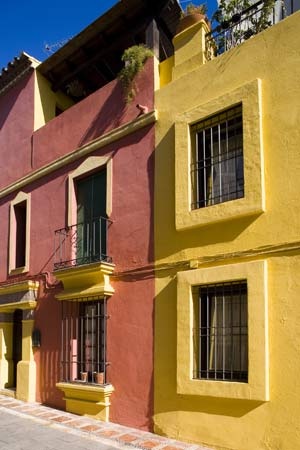 provincia (province) in the comunidad autónoma (autonomous community) of Andalusia, southern Spain, on the Mediterranean coast. Its varied landscapes range from the arid zones of the Guadix and Baza plains in the north and centre to the fertile valleys and beaches of the Costa del Sol in the south. Granada is not a wealthy province. The economy is predominantly agricultural, with cereals (barley and wheat) as the most widely grown crop, although sugarcane and, especially, tobacco are also important. Olive and fruit trees (oranges, lemons, figs, almonds, and pomegranates) and vineyards are common. The principal industries are agriculture-based and include sugar refining, although manufacturing is carried on in Granada city, the provincial capital.
provincia (province) in the comunidad autónoma (autonomous community) of Andalusia, southern Spain, on the Mediterranean coast. Its varied landscapes range from the arid zones of the Guadix and Baza plains in the north and centre to the fertile valleys and beaches of the Costa del Sol in the south. Granada is not a wealthy province. The economy is predominantly agricultural, with cereals (barley and wheat) as the most widely grown crop, although sugarcane and, especially, tobacco are also important. Olive and fruit trees (oranges, lemons, figs, almonds, and pomegranates) and vineyards are common. The principal industries are agriculture-based and include sugar refining, although manufacturing is carried on in Granada city, the provincial capital.The province contains the lead mines of the Sierra de Gador (the richest in the world during the 19th century), and the Marquesado de Zenete region is one of Spain's largest producers of iron ore. The Granada coast (part of the Costa del Sol) includes the thriving beach resorts of Motril, Salobreña, and Almuñécar. Other important towns are Guadix, Loja, and Baza. The service industry, especially tourism, has grown in importance. Area 4,883 square miles (12,647 square km). Pop. (2007 est.) 884,099.
- Duun, Olav
- Duval, Claude
- Duvalier, François
- Duvalier, Jean-Claude
- Duvall, Gabriel
- Duvall, Robert
- Duve, Christian René de
- Duveen of Millbank, Joseph Duveen, Baron
- Duveneck, Frank
- Duvergier de Hauranne, Jean, Abbé de Saint-Cyran
- Duvet, Jean
- Duveyrier, Henri
- du Vigneaud, Vincent
- Duvivier, Julien
- Duwaym, Al-
- Duxbury
- Duyckinck, Evert Augustus
- Duy Tan
- Duyun
- Duṭṭhagāmaṇī
- Dvaita
- Dvaravati
- dvija
- Dvořák, Antonín
- Dvůr Králové nad Labem